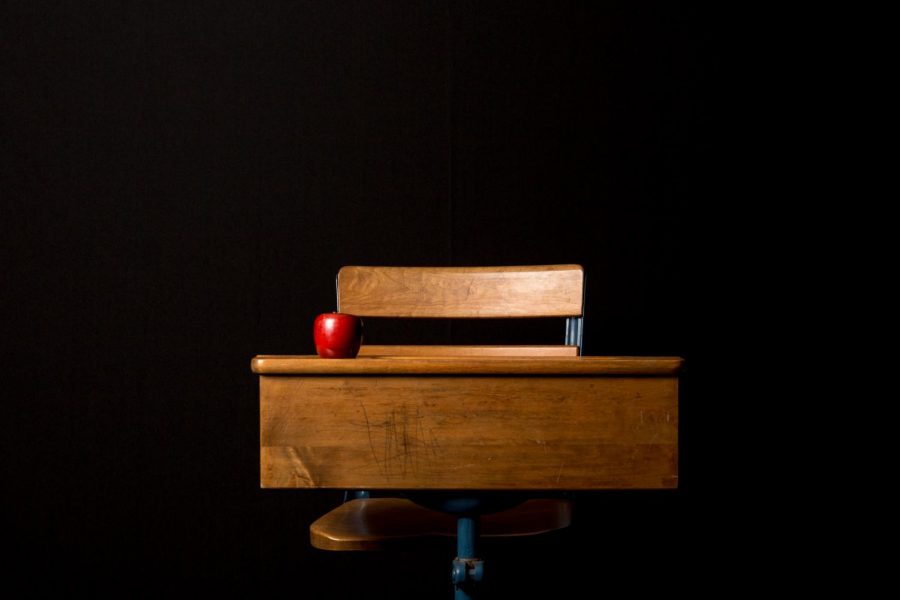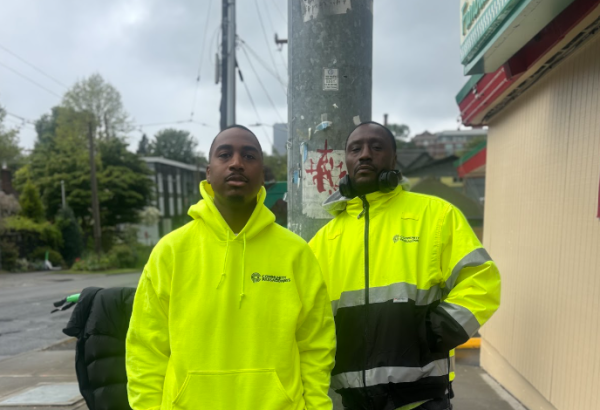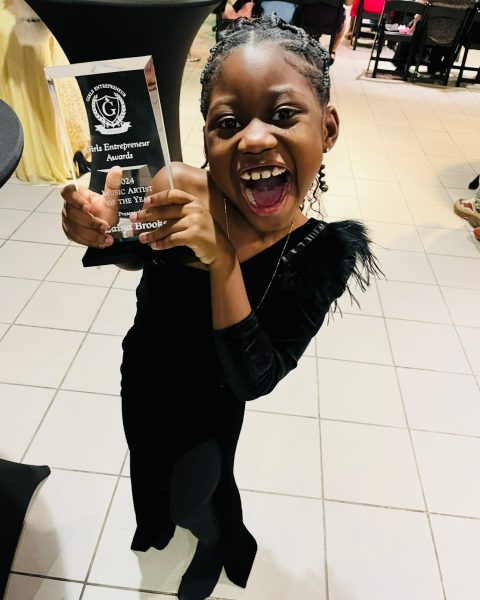Special Ed @ Garfield
A look into special ed at Garfield.
“She loves bracelets. She has an obsession with bracelets – she’ll put them on her nose or balance them on her head.” Senior Josie Barker said of her younger sister, Therese. This year is the first time they’ve gone to the same school together, and Barker said they used to hang out a lot, often bringing her sister Starbucks or saying hi to her in class. “But now when she sees me,” Josie said, laughing, “She tells me to go away because she’s with her friends.”
Therese was born with a condition that can make speech and movement challenging, which qualifies her to be in the Special Education program at Garfield. Although this is in no way what defines their relationship, Therese’s involvement in the Special Ed program has given the sisters a lot of insight into the misconceptions around the program and its students.
What is Special Ed?
Overall, Special Education is a program that is designed to accommodate the needs of individual students who require guidance in their education.The special education program is required by the state to fit the specific needs of each individual student, provide access to general ed classes, and teaches material that meets State standards for that grade level. According to state reports, Seattle Public Schools serves 7,000 students in Special Ed programs, which accounts for roughly 13% of our student population.
One of the biggest unknowns about the Special Ed department is how it is divided, and what classes there are. Dylan Koutsky, department chair of the Special Ed program, said there are five programs in the Special Ed department. The largest program in the school, hosting about 100 students, is a resource program that serves students with learning disabilities like ADHD. Mr. Koutsky said, “It’s really just for people who learn a little differently or need more processing time or support with organization.”. Most of these students spend their time in general ed or advanced placement classes throughout the day. Another program, called “Access”, is smaller and provides more heavy support with organizational skills, task completion, and study habits. There are also more specialized programs such as ones that focus more on developing social and emotional skills, functional life needs, or even just more intense academic support.
Each student has their own case manager, which is basically like their own personal counselor. “The case managers work closely with students,” said Mr. Koutsky, “and they figure out what type of accommodations and modifications would help them succeed the most.” This system of each student being able to communicate their needs to their own case manager makes the special ed classrooms much more personalized and involved.
Where does Special Ed take place?
Students often assume that the Special Education is separate or very different from what we consider “General Ed” classes. However, most of the SPS Special Ed students spend 80% of their day in general or advanced classrooms, according to Seattle Public Schools reports. Mr. Koutsky stressed that this is arguably the biggest misunderstanding about the special education program. “When people hear special education they often think of [students] on the more high need end of the spectrum, but there’s a huge variety of students within the program,” Koutsky said.
Koutsky gave an example of a student he knows who is in all AP classes, but just needs a few weekly reminders to turn in homework and other organizational assistance from cse manager. “It does not always look like a self-contained, super high support environment,” he said. Special Ed is often pictured as a service for students with severe disabilities, but Koutsky said we should be defining it by the simple fact that “not everyone has an easy time with education or learns the same as everyone else.”
There is no blanket statement for what a schedule or school day looks like for a student in the special education program. There are students who spend their entire day in Advanced classes and students who spend scheduled time in separate classes focused on social or emotional skills. There are students who recieve Special Ed services excelling in every facet at Garfield. “There are students with Special Ed services that are starting varsity athletes, on ASB, leaders n clubs and in every program at Garfield,” said Koutsky. This is why the special education department is the largest program at our school. There are approximately 140 students in Garfield’s special education program alongside 9 teachers and 16 instructional assistants including one on one assistants and program assistants.
Who runs it and how is it funded?
It’s been quite a rocky road with funding in the past few years. In 2015, the state withheld $3 million of Special Ed funding because of so many parental complaints about the Seattle Public Schools Special Ed program not being comprehensive enough for their kids. Although the district worked hard to swiftly resolve these complaints, the withheld funding was seriously damaging the Special Ed programs. Luckily, the SPS board voted to gradually restore this money as long as Special Ed departments showed progress.
Since 2015, the budget granted to Seattle Public Schools from federal and state sources has increased by approximately $23 million dollars. However, proportionally the budget for Special Education makes up approximately 16% of Seattle Public Schools funding which is the same as 2015 according to the 2017-2018 SPS budget report. For Garfield’s Special Ed program, the funding has been relatively satisfactory in recent years. “For the most part it covers what we need. Students can always use more support and it would be great to have more people in the building that can support on all levels,” Koutsky said. However, Mr. Koutsky has hopes to improve the Special Ed. program at Garfield and in order to pursue those hopes, an increase in funds has to coincide.
Looking to the future
One of the goals of the special education department chair, Mr. Koutsky, is to increase the inclusion of special education students into general education or advanced classes through co-teaching. Co-teaching is the idea of having two teachers facilitating a classroom environment, one with a special education teaching certification and one with a certification in the subject area. In order to teach a special education classroom, teachers have to receive a special education certification. However, this certification is not content based but is instead focused on the delivery of content. “That certification is how you can teach something not what you’re teaching” Koutsky said.
Once a teacher receives their special education certification, they can teach any class as long as it is in the special education setting. “There’s a really high need for special education teachers, which is part of the reason why they did that,” Koutski said of the certification program, “but it allows for someone with not as much content knowledge to be teaching a high school content course which does not seem equitable to me” Koutsky said.
Co-teaching advocates for an equitable learning environment for all students through having rigorous content knowledge as well as stronger support systems to make sure the content is being delivered in an accessible way for everyone. The processing of implementing co-teaching has already begun at Garfield. “We have Algebra One right now and are hoping next year to grow to Geometry and Language Arts too” said Koutsky.
Barker hopes for changes to be made within the student body here at Garfield as well as the general public. There was one particular disheartening moment Barker recalled that highlighted the need for change within our society. “One time, the front wheel of [Therese’s] walker fell off, so it flipped and she fell and split her chin. Our nanny was freaking out and asking someone nearby to call our mom, and they didn’t look. They didn’t look at her, they just kept walking.” said Barker.
This invalidation and blatant disregard for another human being while in a moment of distress in unacceptable. There are actions we can and should take as fellow students to increase inclusivity and Garfield and formulate a more welcoming environment for everyone at the school. These actions can start off with seamingly simple and everyday habits. “They’re still a person – they’ll laugh and say hi and acknowledge you . . . they hear you. So don’t be shy to say hi, because they’ll say hi back.” Barker said.
Mr. Koutsky points out that inclusion should also take place in the classroom, reminding students to “be open and welcoming and friendly and recognize that there are people who have different opportunities for education than others have.” He advised that if you notice someone who may have trouble keeping up in class, support them as a peer. “It’s not specific to students who have special ed services,” he said, “but to students or peers who are struggling, lend a hand and help out.”
Another really easy way to get involved in the process of making Garfield more integrated is through joining programs that promote the integration of special and general ed, such as Project Unify, a club that meets at lunch on Wednesday in room 327. Project Unify provides an opportunity for the integration of students with Special Ed services who have conditions that make speech or movement challenging into sports. Junior club president, Gracie Sullivan is thankful for the opportunity to be a part of the club. ““Being a part of Project Unify has really opened my eyes to different communities at Garfield. It feels really special to be able to be close to people in a community I wouldn’t have been in if I wasn’t a part of the club.” Barker also suggested participating in one of the various Seattle summer camps that support special needs students that she and her sister go to regularly.






